page 4
~ The Study of Threes ~
http://threesology.org
| Hybrids page 1 | Hybrids page 2 | Hybrids page 3 | Hybrids page 4 | Hybrids page 5 |
| Hybrids page 6 | Hybrids page 7 | Hybrids page 8 | Hybrids page 9 | Hybrids page 10 |
| Hybrids page 11 | Hybrids page 12 Playmate God |
Hybrids 13 Economics 1 |
Hybrids 14 Economics 2 |
Hybrids 15 Economics 3 |
| Hybrids 16 Economics 4 |
Hybrids 17 Economics 5 |
Hybrids 18 Economics 6 |
Hybrids 19 Economics 7 |
Hybrids 20 Language 1 |
| Hybrids 21 Language 2 |
Hybrids 22 Language 3 |
Hybrids 23 Language 4 |
Hybrids 24 Physics |
Hybrids 25 |
| Hybrids 26 | Hybrid 27 |
Visitors as of 30th July, 2021

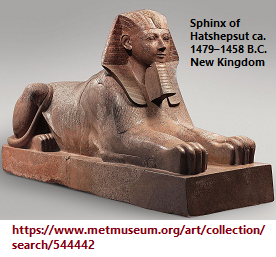
Generally, when on speaks of a hybrid, they might necessarily need to use some word like 'mythology' to prompt a person's memory, because words like fluctuation, intermittancy, temporalization, cadenced, regurgitation, etc. are not likely to create any direct correlative response. However, if the word "mythology" is not enough, someone might have to follow this with an example such as saying a two-headed beast or make a reference to something which might be familiar like an Egyptian Sphinx, while at the same time describing a sphinx as a creature with a lion's body and a human head. However, if one tries to then introduce the idea that any and all dichotomies can be perceived as a type of hybrid, the person may or may not agree... preferring to limit the definition to animate creatures and not mere ideas from any and all subjects. Yet, if they are flexible in their thinking and permit a larger definition, we might want to pursue an enlarged philosophical discussion involving numerical quantity and quality, to the extent that in order for something to be a hybrid, there must be at least two separate items inter-meshed as a single reference such as a typical on/off light switch, or an extended variation involving a slow- medium- fast selection panel.
Hybrids begin with a pattern-of-two (having one part this and one part that)... such as is described by mythological hybrids which can be listed by century, moving forward in time to the present era. Sometimes called creatures, monsters, gods, demons, devils, messengers, (perhaps even one's next door neighbor or workplace boss). However, both the quantity and quality of hybrids is actually quite small. In other words, if you look at any list, you might be lucky to find 100 total examples, though most of the time it is less than 20 or 30. In addition, if we look for a pattern-of-one hybrid, we might be quick to claim that no such creature could exist. Yet, a "one" hybrid can be seen from the perspective that it is a singular part of a composite, such as an electron which is said to be indivisible and yet participates as a 1-in-3 ensemble of atoms. Though we don't characteristically view a single item as a hybrid, this should not stop us from seeing that a single item can be a part of a composite which is a hybrid, and thus find ourselves in a realm of psychology where "loners" are typically where they are due to what is sometimes referred to as a constellation or matrix or or complex of reasons... and thus portrays a hybrid situation that some may overlook because they are too focused on a singular outcome of a larger situation. Others come to see the dynamics of what caused the person to be a loner and instead may see a many-headed hydra standing in plain sight in the shadows of everyday activities most of take for granted as rational, real, and normal. Although some consider loners to be creative, intelligent, sensitive or have some hidden uniqueness that conformity in a social group might squash or attempt to mold it along the lines of the group's views to the detriment of the individual's individuality, the point to be made in the present context is that the individual is part of a hybrid situation.
When we look at social group classification schemes, the quantity of 1, 2, 3 and four play out in the following examples. Most of them are dichotomies and none of them use a formula where multiple realities are listed, though they may exist in practice:
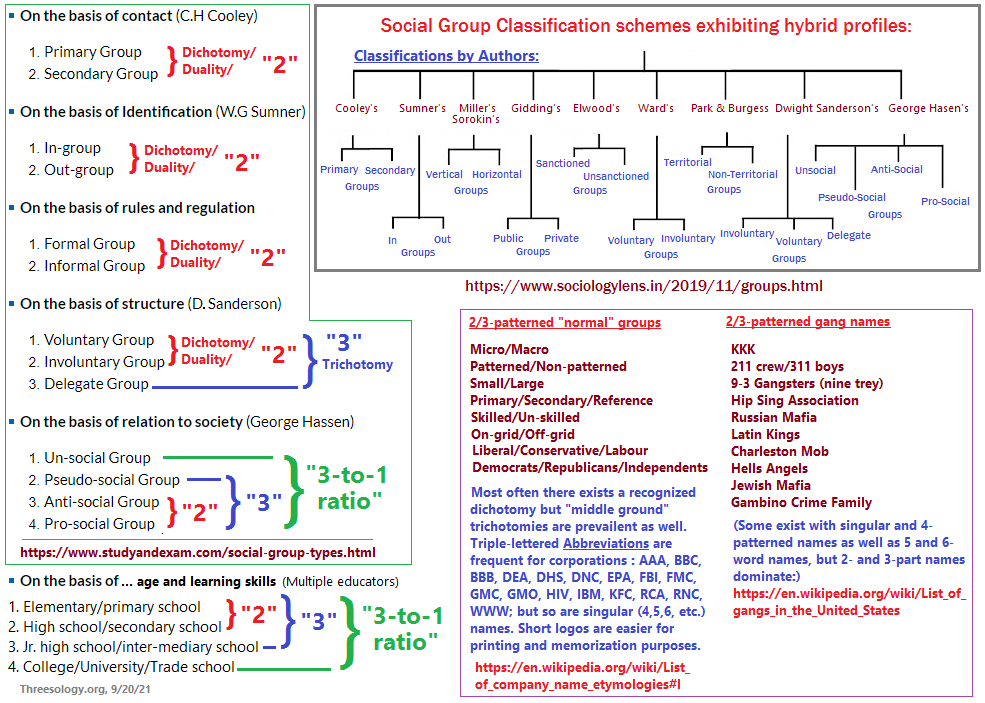
It is too soon in human history for anyone to reference aliens or extra-terrestrials as example of hybrids, since so often we of the present day give aliens singular identities and not composite ones; though people in the future might well views the concept of aliens as a characteristic example of hybrid thinking comparable to those creatures in the past which have become labeled as examples of hybrids. By recurringly naming three prominent types, the composite represents a hybrid of cognitive activity. Notwithstanding that we humans may one day encounter an alien sentient being from outside Earth and the present Milky Way galaxy which looks like one of the images we of today have come to construct, it is of need to point out that there has been a recurringly representation of three-to-1 ratio types of Aliens (supposedly commonly encountered): Greys, Reptilian's, Nordics, and Hybrids, though there are others interested in describing their research interests who have created their own variations. Hence, the recurring three can be viewed as a type of 3-in-1 portrayal of an assumed cognitive imperative that is not necessarily seen as an "imperative" (or else everyone would be reciting the same information) because examples have just begun to become catalogued and others may well be in the beginning stages of development.
In other words, while there are prominent historical examples of the 3-in-1 ratio that one might refer to as a 3-to-1-ratio exhibited by the Trinity of Christianity (3 persons in 1 godhead) and a modern technological expression in the three engines used in one space shuttle, as well as multiple other groups-of-three which can be interpreted in this formulaic way, the idea is not a customary organizational reference used by researchers. If we make a clear distinction between a four-item composite idea that is a three-"to"-one ratio and a three-item composite as a three-"in"-one ratio, we thus have two related but different models. By adding a middle term of "and", "but", "from", "instead of", "out of", "for" or some other conjunctive interpolation; we thus develop multiple categories which, in a binomial nomenclature would fall into sub and branched categorizations.
While some researchers might be humored by a portrayal of aliens and think that further reading is not worth their time, they fail to recognize a modern expression of aliens may well be a characteristic cognitive exercise to be related with mythological creations of the past. However, in some instances when a researcher does provide what some observers may think is an example not to be take seriously, it is necessary to follow the example with more serious, more "real" characterizations of hybrid animal forms, since humans are part of the animal kingdom and it is quite likely that most aliens will be categorized as being an animal... insect and ghostly as well as aberrational, A.I. and alternative ideological ones notwithstanding.
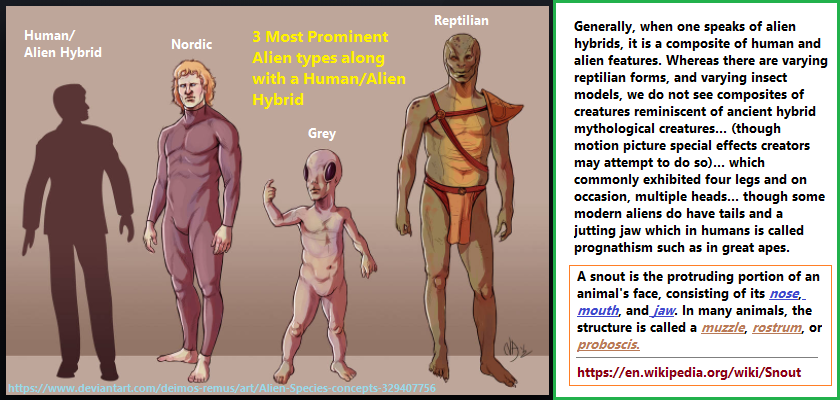
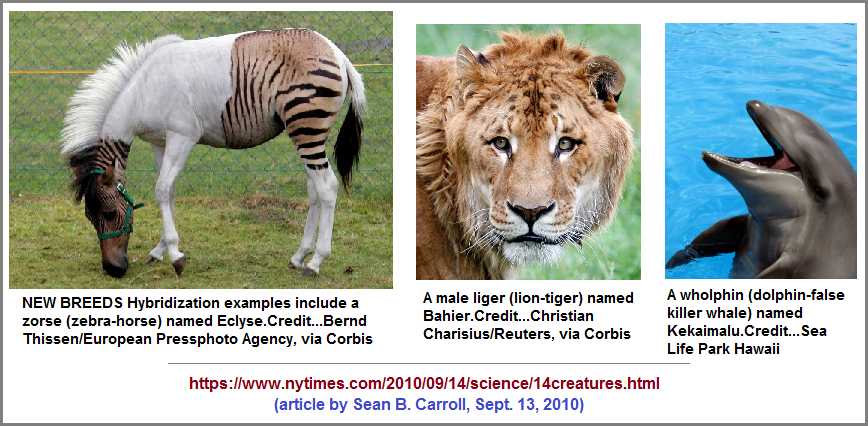
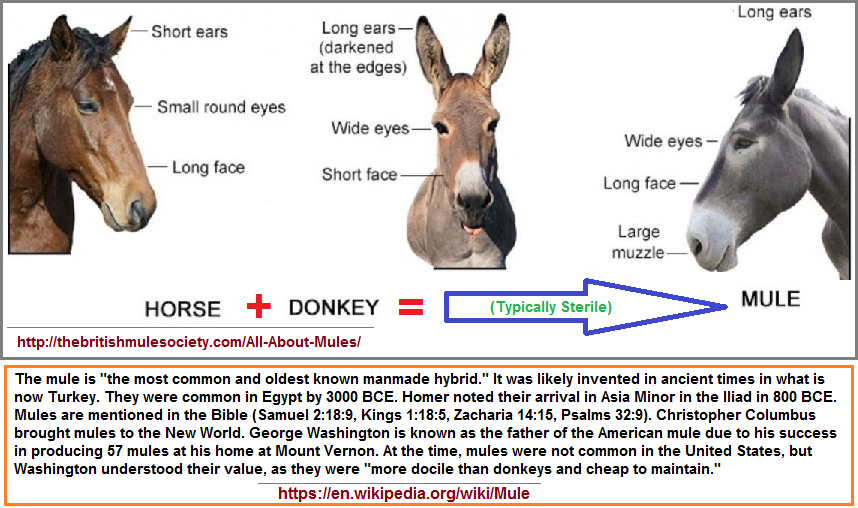
Mule
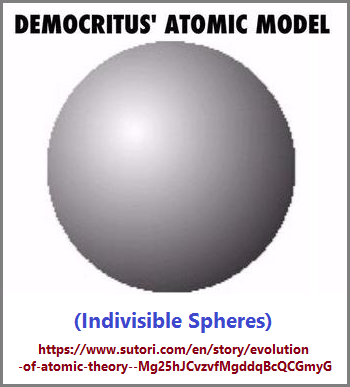
If we turn aside from the animal kingdom and focus our attention on the real but unseen (with the naked eye) world of atoms, another example of the 3-to-1 ratio is found in particle physics. A single idea such as the (previously supposed indivisible) atom is itself a composite of 3 sub-atomic particles; while (in addition to this) the Protons as well as Neutrons each have three quarks and three anti-quarks. Hence, when we speak of a singular item or singularity concept, such an item or idea may be an unrealized alloy of two or more parts. While someone may claim that an Electron has no parts, this betrays the fact that it is a fractional 1/3 of the 3-part Proton- Neutron- Electron composite. In other words, the Electron, the Proton, and the Neutron are... in essence, each a third slice of the atomic pie. It is difficult to think of the Electron as existing without as a stand-alone entity. Hence, while an item may be indivisible by current means of testing and interpretation, it is as such by being a part of an association. In this sense, its divisibility is itself... like a me- myself- I composite which may have three distinct personalities in some people... that is, upon closer examination, though from a psychology perspective one might refer to the Id- Ego- Superego, if not the disposition manifested to exhibit an orientation based on a cultural orientation within the sphere of one or more of the 3 traditional assignments of a lower- upper- social class influence and behavioral distinction.
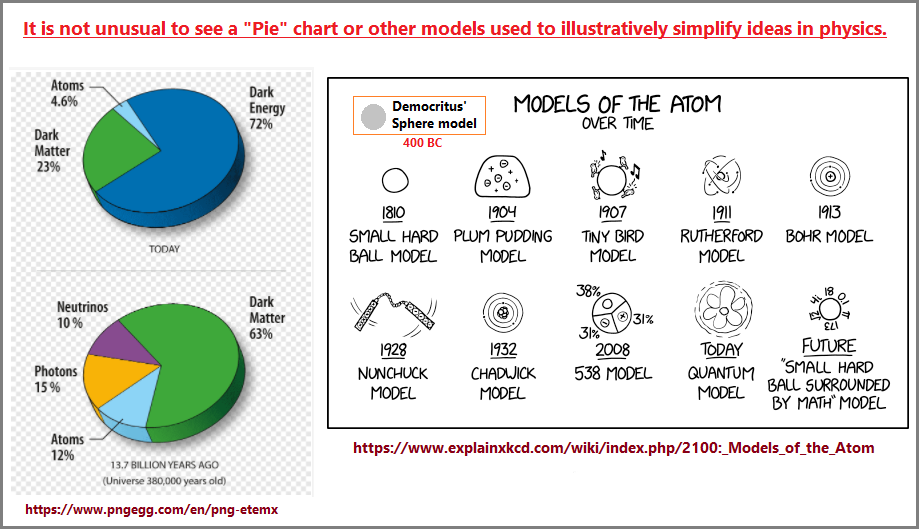
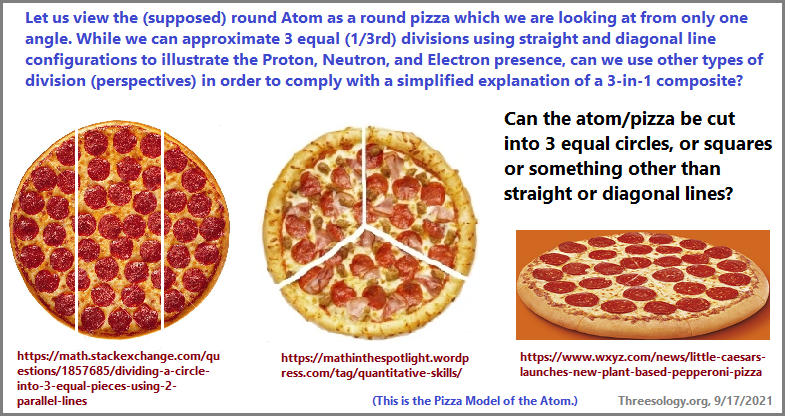
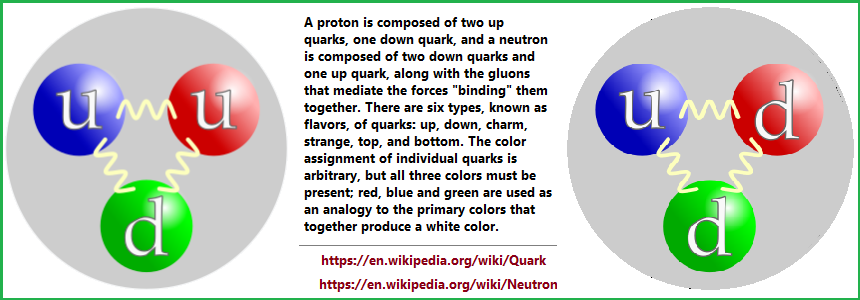
With respect to the "Pizza Atomic model" we simply need to determine how many slices of pepperoni and other ingredients are actually contained in the atomic-pizza. No less, what would it taste like and will it require an "acquired" (intellectual) taste?
The pie chart idea is not to be confused with Thompson's Plum Pudding Model. Here are a couple of links for the pie chart image concerning matter in the Universe:
However, I did come up with a Pumpkin (or Jack'o-lantern) model for the Quark/gluon matrix assemblage:
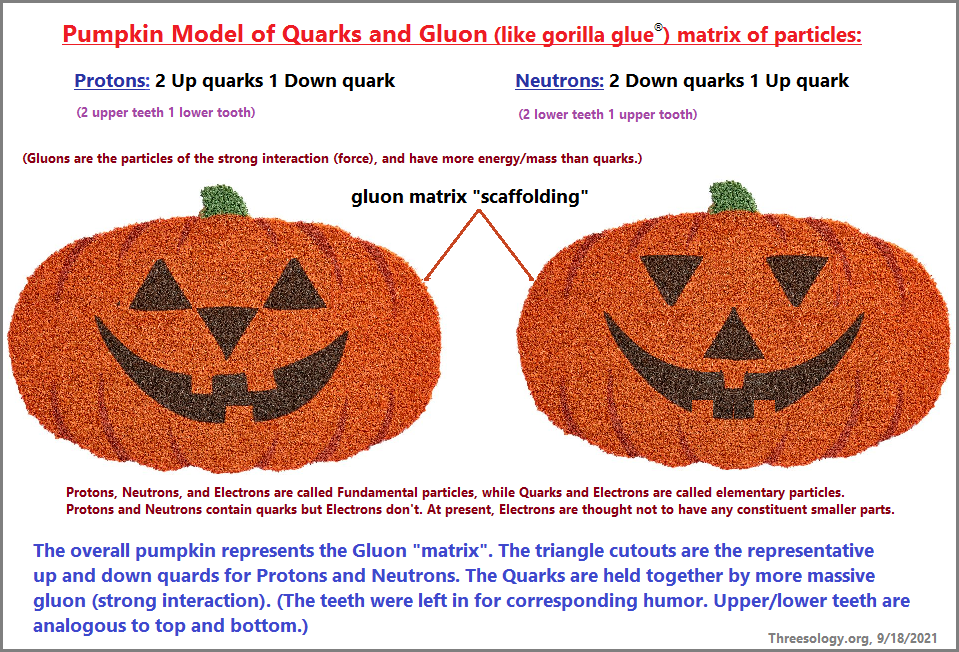
While one might first think that the pie slices/wheel spoke spaces represent the quarks and the lines/spokes represent the gluons (cement/nails/screws, etc...) However, because the energy-mass of the gluon dwarfs that of the quarks, it is necessary for us to visually switch the labeling. (Most of the mass comes from the binding energy of the strong interaction.) Hence, the rim, hub and spoke delineations (in-lines as opposed to the notion of "outlines"), actually represent the quarks while the larger spaces are the gluons. It is necessary for us to flip the idea around (or inside out) just as it is necessary to reconsider the need for developing particle decelerators instead of particle accelerators, because difficult-to-see/detect particles require that we speed up their surrounding environment(s) just as we place stationary cars and aircraft in wind tunnels filled with a gaseous content to illuminate external configurations of the objects (particles) being tested. We do not actually know how many particles actually exist in a stationary state and only move when acted on by something in their respective environments. Many a predator and non-predator has developed camouflaging techniques, whether intentional, accidental or by way of mutation... and may not even be aware that they have such. The use of a particle accelerator is tantamount to someone trying to get an animal to move into view, but any particle that has learned to be incredibly patient or simply hibernate, can not be rousted from a position in which it may sit like a rusted ball bearing in a sleeve (race) or a penny in a difficult to pry open penny loafer "front pocket" (at least that's what I am calling it now on the spur of the moment). Allusive particles are like hard to catch animals which need different techniques than mere setting conventional traps, duck blinds, poisons, hunting dog partnerships, or seeking out a natural predator to scare them from their nest, hole, or whatever conclave... that may effect a criminal's type of "hiding in plain sight".
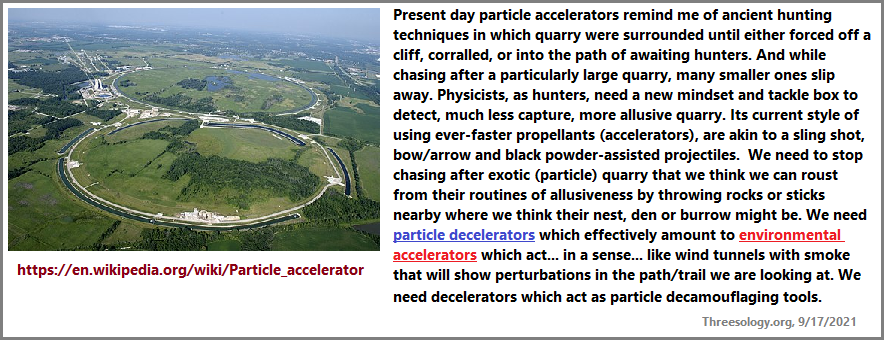

Let us look at some hybridization and shadows in other physics topics:
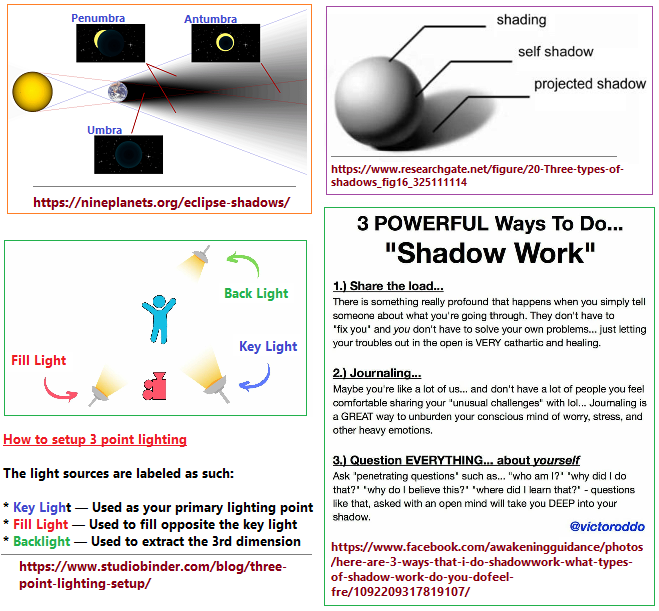
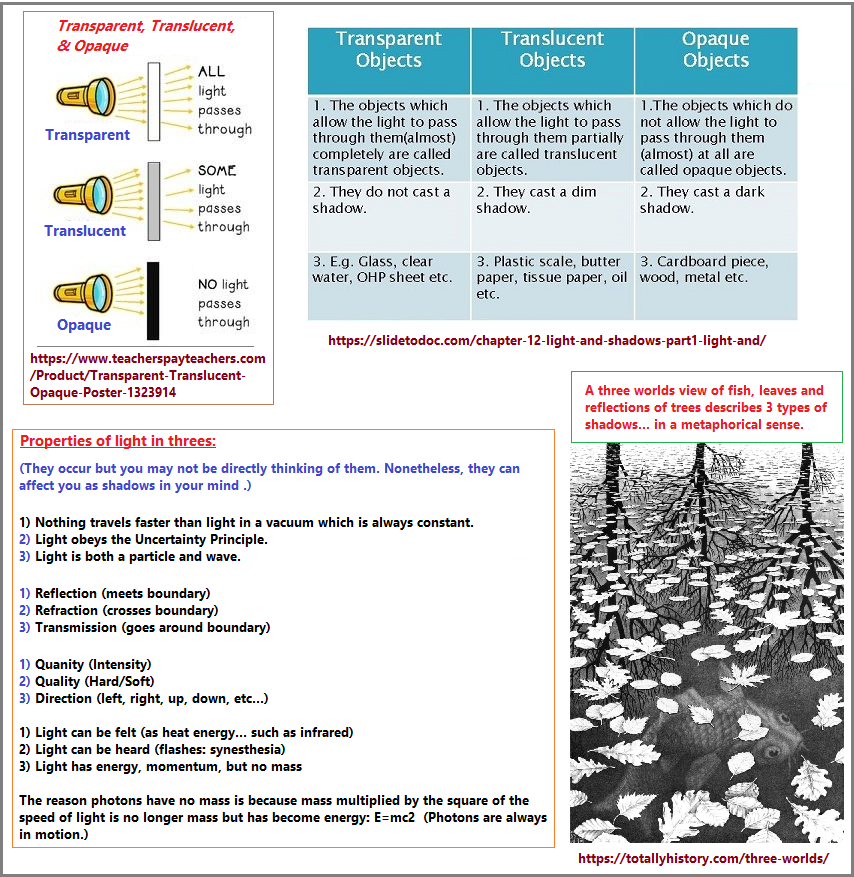
Here are the links for the above list of light properties in threes:
- Strange Properties of Light by Anonymous, March 1, 2018
- Physics Weekly: Reflection, Refraction, and Diffraction
- The 3 Basic Properties of Light in Photography
- One in Five People May Be Able to “Hear” a Flash of Light by Jason Daley, Jan. 18, 2017
- Does Light have Mass? by Philip Gibbs 1997
- Why don't Photons have mass? by Jason Spires, July 18, 2014
- What exactly is a photon? Definition, properties, facts by Tibi Puiu, Jan. 28, 2021
Many hybrids come as dualities, as dichotomies, as pairings, as twins, as one's doppelganger:
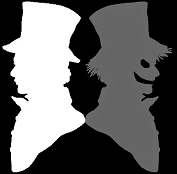
According to age-old German folklore, all living creatures have a spirit double who is invisible but identical to the living individual. These second selves are perceived as being distinct from ghosts (which appear only after death), and sometimes they are described as the spiritual opposite or negative of their human counterparts. In 1796, German writer Johann Paul Richter, who wrote under the pseudonym Jean Paul, coined the word Doppelgänger (from doppel-, meaning "double," and -gänger, meaning "goer") to refer to such specters.

Sources for Doppelganger, Snake, Skin and cartoon images:
- Digital populism of Ukrainian presidential campaign has inflicted a deep wound, Deresh says
- Systematics of the Neotropical Snake Dendrophidion percarinatum (Serpentes: Colubridae) by John E. Cadle
- Witchy Tips
- Snake skin cartoons and comics
Alternatively, I should include some links to ideas governing what one or another author thinks is appropriate to list as a representative shadow illustration:
- Wikipedia: Shadow (psychology) In analytical psychology, the shadow (also known as id, shadow aspect, or shadow archetype) is either an unconscious aspect of the personality that the conscious ego does not identify in itself, or the entirety of the unconscious, i.e., everything of which a person is not fully conscious. In short, the shadow is the unknown side.
- Role of Shadows in Art History by Cinzia Franceschini, 4/05/2021; (For example:
- Drawing Shadows to Mimic Reality
- Shadows as Spatial Elements
- Shadows and Dramatic Effects
- The Darkest Part of a Shadow: Symbols and Mystery
- Contemporary Shadow Art
- The Art of Shadowboxing Why We Shadowbox; here are some benefits:
- Form: Shadowboxing is the perfect opportunity to focus on your form.
- Technique: Once your form is down, you can start focusing on your technique. (Fixing bad habits, developing better ones.)
- Movement and Balance: Movement and balance are important components of being in the ring.
- Muscle Memory: One of the greatest benefits of shadowboxing is muscle memory. Muscle memory is the phenomenon of being able to perform complex tasks with ease, accuracy, and seemingly on autopilot.
- Mindfulness: Mindfulness is the state where your mind is fully attentive to what is going on in the present moment; your surroundings, your actions, your thoughts, and feelings.
- Shadow Meditation: Shadowboxing is the only portion of the training session where there is no external feedback. There is no bag and there are no mitts, directions, or landmarks. It’s just you focusing inward on your form and technique. Take cues from how the movement feels, how your punches flow from the floor, through your hips, through your shoulders, and into the punch.
- Exercise: You might think of shadowboxing as more of a warm-up than an exercise, but it's actually a great full-body workout.
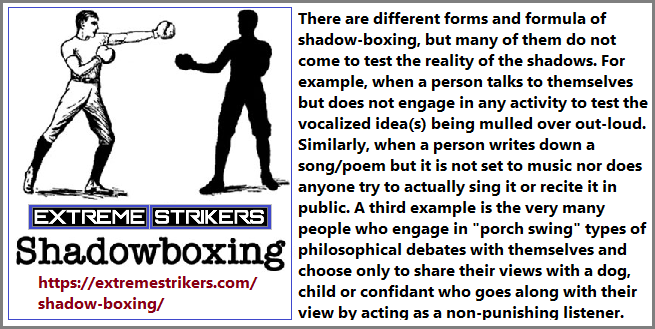
The typical reference to a shadow in terms of a physics explanation is to say that it is the darkness where there is no light. While it is a simplified reference used for young kids, we adults know that a shadow can consist of shadings from light to dark, with the lighter regions being labeled a shaded area and the darker or blackened areas as a descriptive shadow. Nonetheless, an object may allow some light through itself which lightens an otherwise darkened or blackened spot which portrays the object's silhouette. Hence, at this point let me bring to the fore the view that there are three parts to a shadow called the umbra, penumbra and antumbra, just as there are three general degrees of light penetration called Transparent, Translucent, Opaque.
Exploring the concept of "shadow" with respect to hybrids, we need to expand the representative definition because it is actually a metaphor for multiple ideas where pairing is directly known or suspected (like the presence of a planet because of ), whether as a perceived compliment and/or oppositional (in the sense that one would not know of itself or operate as it does if it were not for the presence of a perceived dichotomy... for example, man would not know of himself if it were not for the woman). While the word "doppelganger" has already been used and is well-known by some, let me introduce a coinage of my own labeled as "Doppler-ganger" where the ideas of shadows, doppelgangers and the Doppler effect are combined. By so doing we can enlarge our understanding and definition of the initial shadow word to encompass multiple subject areas who researchers may or may not have difficulty in using a metaphorical treatment as part of their examination protocols. For example, we find three types of research techniques to discover planets hiding in "shadows":
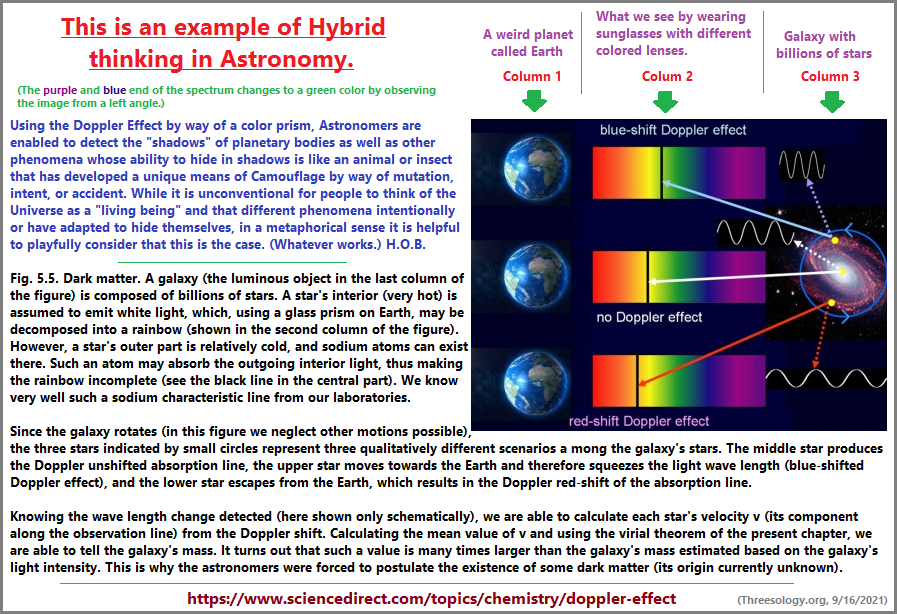
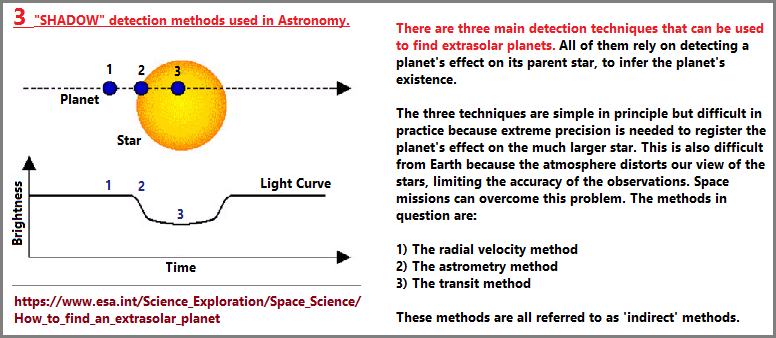
Now that we are on the subject of shadows being used as a metaphor, let us look at some other ideas where activities involve shadows:
- Copyright infringement: This is where one person's copyrighted work is copied by another who may try to conceal the infringement by manipulating content and/or design and/or application to exhibit a proposed original expression but actually portrays a shadowing effect of the initial creation. However, this is not to say that two or more people may independently create similar ideas without an intent to cheat anyone. Because some people work in the same field which may have sociologically determined constraints or Natural law constraints, the human brain may necessarily derive similar ideas with slightly different wording due to language differences and culturally determined orientations for illustration.
- Plagiarism (Note, while this link provides four types: Direct, Mosaic, Self and Accidental, it is clear we can view this as a three-to-1 ratio): This is similar to copyright infringement except that a creation may not be (as yet) copyrighted or has not yet been published except for in a small setting in which those who are privy to the revealing take it upon themselves to use the same material so as to attempt to garner recognition for an original idea. If a subordinate's work is plagiarized by a superior, the superior may get the credit as has been the case on several occasions in different subject areas. The social standing ("clout") of a superior may be such that those they associate with are in positions to assist in a given public accepting the work of a noted professional instead of a labeled underling who may be claimed are attempting to step out of the shadow of a great person into their limelight.
- Plato's cave: (Involves three stages of liberation... Freed from chains, Outside the cave, Eyes become adjusted to looking directly at the Sun... so to speak, and not a reflection nor shadow of it). Plato's cave involves prisoners who attempt to discern reality from shadows on a cave wall(s) due to flickering torches (or candles) and perhaps bits and pieces of sunlight as the Earth turns. In essence, the point in the present case is to illustrate the dichotomous shadowing effect between differently perceived realities based on one's circumstances where a person's mind (for whatever reason(s) may be constrained in some way, preventing them from seeing reality without fetters. Hence, a realty of shadows exists which many people hold near and dear to themselves, while others... whom the shadow believers argue against, are enabled to question whether they too are nonetheless living in a shadowy realm that is being described as a clear out-in-the-open reality as it is defined.)
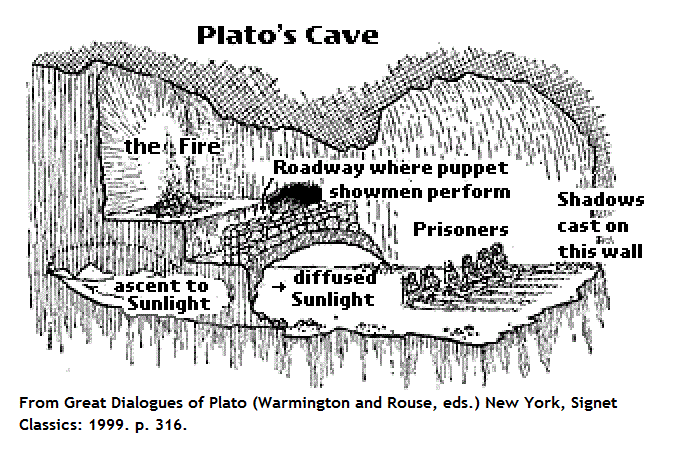
Image Source: The Allegory of the Cave
While the above image and associated comments are meant as a metaphor for the present discussion, it has been this writer's experience that the idea is not readily understood without some extended parallels being made for those of today. To such an end it is high time that the allegory of the cave was made more applicable to today's standards of imagery production, even if an appreciable grasp of the finer details of Plato's intent is "lost in translation". Nonetheless, it is of need for us to find some measure of reproduction of the previous image to be cast onto the projected screens of idealism noted by old and young alike in the present era. The following image is an effort to do just this. Our thanks for the image to the "artist" who was quite museful when undertaking the task. And it should be said regarding the allegory, Plato may have been applying a premonition about the future, in a contemporary context and manner of his era; to which he might allude to the forth-coming modern cinema without inviting derisive comments that he was engaging in discussing a fairytale... with respect to the idea of "real images" and not just shadows— being cast on a wall. Instead, the "shadows" he spoke of were more easily apprehended then if he tried to convey the image of shadows representing actual characters in his thought exercise. The following image is my adaptation of the Cave allegory to a modern "Cinema" theme. Interestingly, the cave idea actually did foreshadow the atmosphere of some theaters.
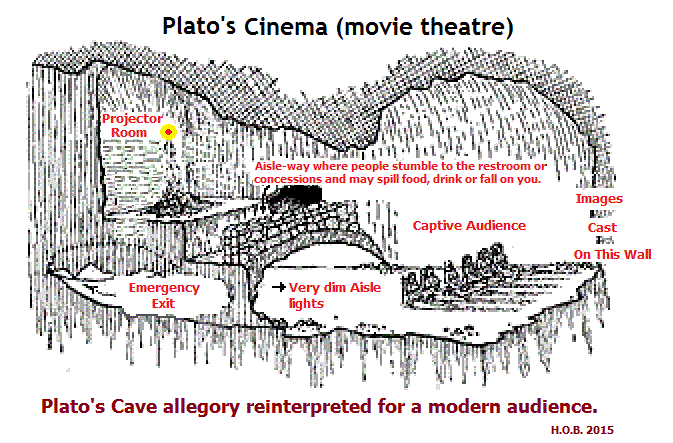
It is difficult for those of today to imagine the (cave-like) eeriness and (illuminating) excitement that a movie theater of the "olden days" presented as part of the overall movie viewing experience. While I can show a floor plan illustration, it says nothing about the smells, textures of the leather (or cloth) seats, dim lighting nor the expectation of a cartoon to be played before the feature presentation. The cost of a ticket and concessions were appreciably cheaper (and let me add... much tastier) than today. And since not every theater had night-light-like lights affixed to the sides of aisle seats or embedded in the floor, we had to be escorted to a seat by a person called an Usher wielding a flashlight. Nonetheless, here is an examples of a place called Garden Theater from Pennsylvania. Though I did not live in Pennsylvania as a child, we too had a Garden Theater, suggesting that it may have been a reproduced standard for many places.

One last example of shadows to be included here are Four Idols of the mind exhibited by Sir Francis Bacon in his Novum Organum "Bacon details a new system of logic he believes to be superior to the old ways of syllogism. This is now known as the Baconian method.
(The) Baconian method (refers to) the inductive method of scientific investigation first set out by Francis Bacon. The method involves the inference of general laws or principles from particular instances observed under controlled conditions (i.e., in experiments). To make sure that any such generalization is valid, the observer must seek not only positive instances of an association between things in which one event or state brings about another, but also negative instances in which the event or state fails to occur in the absence of the other (see method of exclusion; Mill’s canons). Finally, the observer tries to formulate an explanation for the causal connection so established.
(Source: Baconian Method)
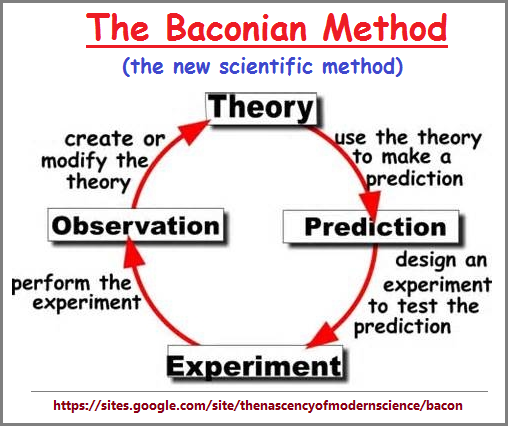
Bacon's Four Idols of the mind can be interpreted as representing various shadows (in a three-to-1 ratio way) described as occurring in a person's mind with relative strengths and weaknesses in coloring and forcefulness of repetition, ambivalence, and application to one's particular circumstances. Such shadows of consideration may be fleeting (like apprehended briefly at the corner of one's eye), or so pronounced as to create conditions which can range from what most people would describe as normalcy for a given era, insanity or somewhere along that characteristic line of straddling between genius and irrationality.
- Idols of the Tribe are deceptive beliefs inherent in the mind of man, and therefore belonging to the whole of the human race. They are abstractions in error arising from common tendencies to exaggeration, distortion, and disproportion. Thus men gazing at the stars perceive the order of the world, but are not content merely to contemplate or record that which is seen. They extend their opinions, investing the starry heavens with innumerable imaginary qualities. In a short time these imaginings gain dignity and are mingled with the facts until the compounds become inseparable. This may explain Bacon's epitaph which is said to be a summary of his whole method. It reads, "Let all compounds be dissolved."
- Idols of the Cave are those which arise within the mind of the individual. This mind is symbolically a cavern. The thoughts of the individual roam
about in this dark cave and are variously modified by temperament, education, habit, environment, and accident. Thus an individual who dedicates his mind to
some particular branch of learning becomes possessed by his own peculiar interest, and interprets all other learning according to the colors of his own devotion.
The chemist sees chemistry in all things, and the courtier ever present at the rituals of the court unduly emphasizes the significance of kings and princes.
- (The title page of Bacon's New Atlantis (London 1626) is ornamented with a curious design or printer's device. The winged figure of Father Time is shown lifting a female figure from a dark cave. This represents truth resurrected from the cavern of the intellect.)
- Idols of the Marketplace are errors arising from the false significance bestowed upon words, and in this classification Bacon anticipated the modern science of semantics. According to him it is the popular belief that men form their thoughts into words in order to communicate their opinions to others, but often words arise as substitutes for thoughts and men think they have won an argument because they have out talked their opponents. The constant impact of words variously used without attention to their true meaning only in turn condition the understanding and breed fallacies. Words often betray their own purpose, obscuring the very thoughts they are designed to express.
- Idols of the Theater are those which are due to sophistry and false learning. These idols are built up in the field of theology, philosophy, and
science, and because they are defended by learned groups are accepted without question by the masses. When false philosophies have been cultivated and have
attained a wide sphere of dominion in the world of the intellect they are no longer questioned. False superstructures are raised on false foundations, and in
the end systems barren of merit parade their grandeur on the stage of the world.
- A careful reading of the Novum Organum will show. Bacon used the theater with its curtain and its properties as a symbol of the world stage. It might even be profitable to examine the Shakespearean plays with this viewpoint in mind.
I previously mentioned viewing the Four Idols as a three-to-1 ratio which may need a moment's worth of explaining for some readers. The first Idol, "Idols of the Tribe" speak of a collectivity (like Carl Jung's Collective Unconscious noted by the concepts of instinct and Archetypes), whereas the others are focused primarily on individual experiences. By bringing the concept of the Collective Unconscious into the present foray, we come to yet another "shadow exercise" of thinking illustrated in the forth-coming list, after a short reference to instincts and archetypes diagramming them as a paired embodiment much like the Yin and Yang complement sometimes referred to as opposites, dualities, dichotomies, polarities, etc...
Instinct and archetype are a pair of opposites, inextricably linked and therefore often difficult to tell apart. Psychic processes seem to be balances of energy flowing between spirit and instinct, though the question of whether a process is to be described as spiritual or as instinctual remains shrouded in darkness. Such evaluation or interpretation depends entirely upon the standpoint or state of the conscious mind. [“On the Nature of the Psyche,” CW 8, par. 407.] (Source: Instinct, Consciousness, and Five Instinctive Factors).
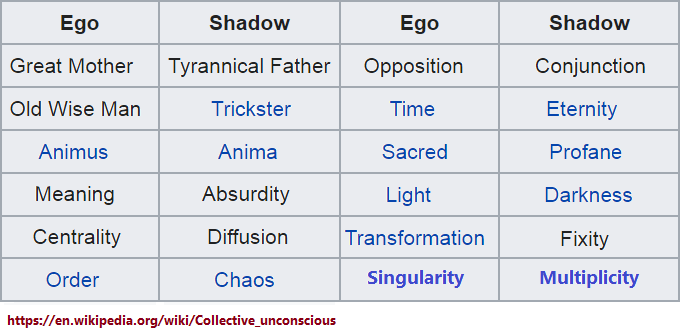
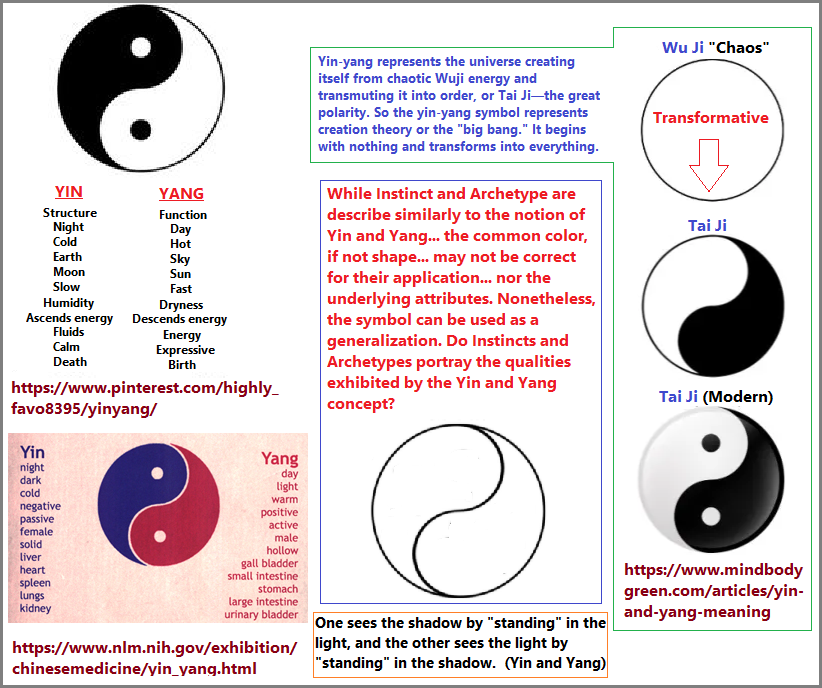
 |
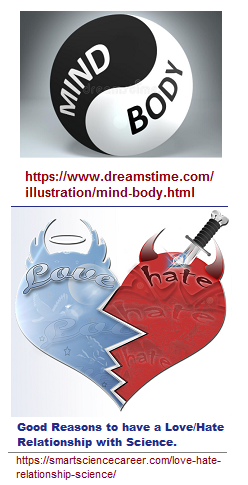 |
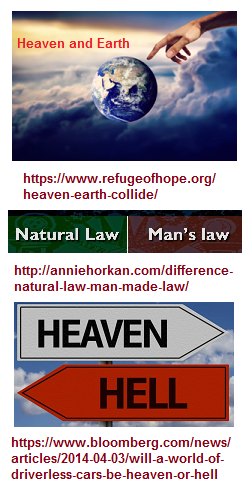 |
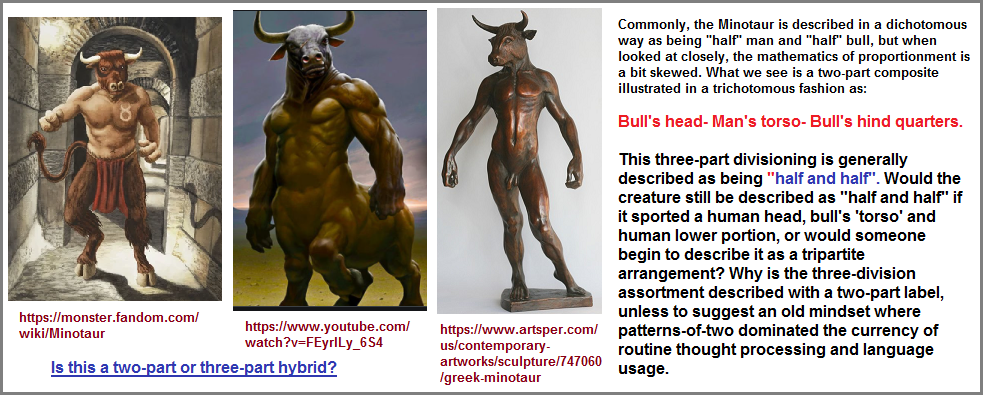
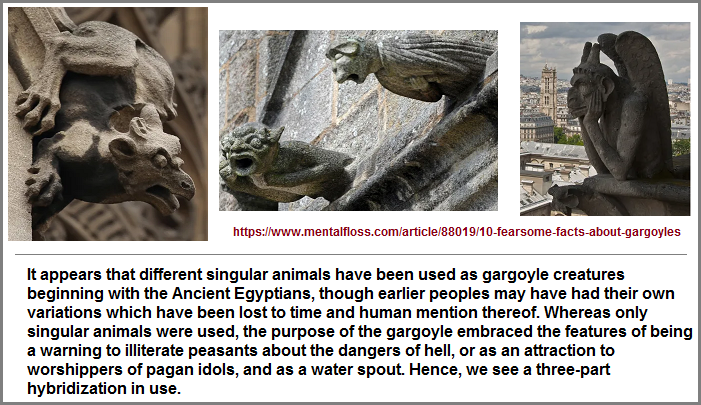
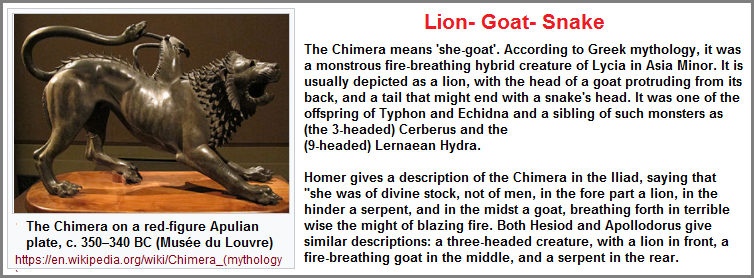
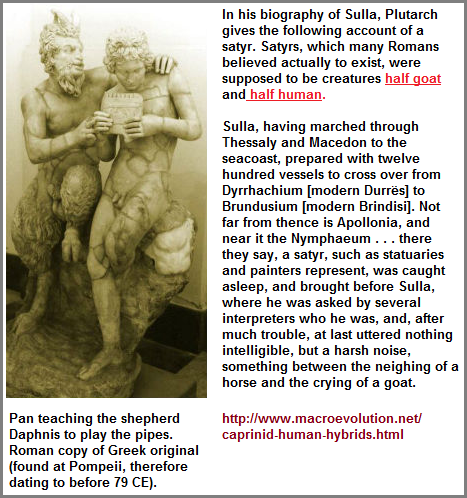
Ancient gods are frequently portrayed as having superhuman abilities but human qualities, much like many different kinds of professionals today. Such occasions represent hybrids, as do those individuals who are referred to as "Jack of all trades, master to none", or someone noted for their multi-tasking ability. While we say that a mermaid is the (lower) half of a fish and the (upper) half of a human female, werewolves (as well as Dr. Jekyll and Mr. Hyde, and even the exploits of Jack the Ripper or anyone engaging in a dual, triple or otherwise multiple role whether or not the role is one in which criminal activity take place); present us with a different kind of mixing human and animal-like or reptile-like qualities. (A person's personality may change or have mood swings, yet not commit any crime.) We might refer to them as someone who engages in shape-shifting (also known as Therianthropy), and is to be distinguished from the idea referred to as a changeling. In any respect, we are discussing the human mind engaging in an act of hybridization. (Jack the ripper by day, what was he by day?)

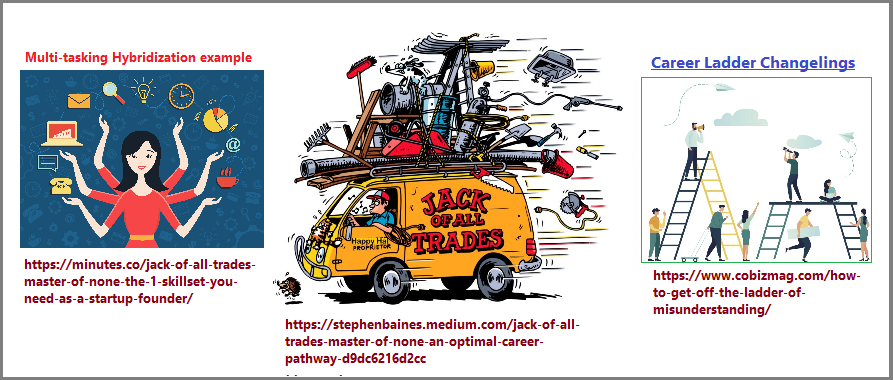

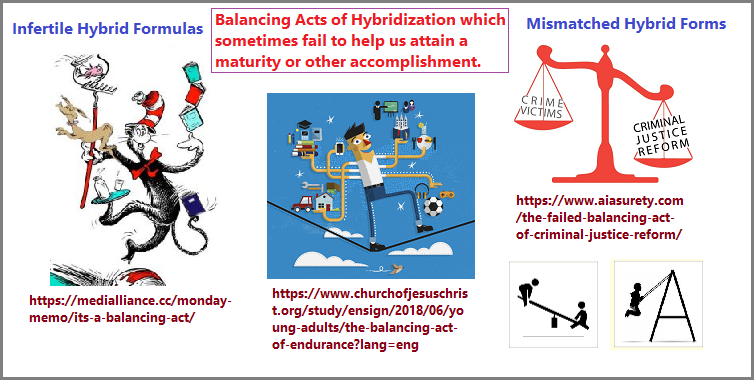
In the above handful of illustrations describing multi-armed, multi-headed (such as in multi-ideas), and multi-role playing, there are multiple other types of multiplicity not similarly illustrated nor described such as multi-emotions, multi-sexual behavior, multi-exercises, and multi-legged... if not multi-heartedness, and multi-separate categories one might care to venture to describe concerning the multi-dimensionality of the human hybrid being created by the multi-effects of culture and environmental multiplicities which exceed the common variety of hybridization called seasonal changes. And as for multi-leggedness, one might describe the "running around" many of us do (in our vehicles) which takes us to several destinations during a single outing such as work, school, store(s), as a delivery/cab service, pseudo-emergency vehicle, etc...
Here are a few of the very many forms of Hybridization taking place in a society stuck in the use of dualities acting as hybridizations of thought processing which the human mind, in many cases, is not maturing out of; and as a defense mechanism, has adopted the rationale of calling such exercises traditions, holidays, accomplishments, needs, proper behavior, Natural, Causal, Normal, Common, Lawful, sacred, useful, regular, etc... And as a reminder, it is of need for the reader to be broad minded when confronted by ideas which they have taken for granted as being described as a form or formula of hybridization. It is sometimes necessary to widen one's typical viewing lenses in order to capture a larger expanse of human behavior so as to see a particular behavior as being one of several... like that of a multi-limbed or multi-constructed (mythological) creature. Indeed, there is no telling what behaviors are common today which will be described as characterizations of hybridization by future peoples shaking their heads in disbelief that such a creature actually existed.
- Shapeshifter
- Changeling
- Mutation
- Bipolar
- Cognitive dissonance
- physically constrained (such as being in jail), chemically constrained (such as the widespread use of legal and illegal drugs, coffee, energy drinks, tobacco, entertainment intoxications, research intoxications, sports intoxications, religious intoxications, or whatever one's drug of choice or imposition has befallen them, etc...)
- Schizophrenic (ambivalence)
- loss of virginity, menopause
- quinceañera (Spanish girl's rite of passage at age 15)
- Bar Mitzvah (Jewish boy's coming of age at 13)
- Bat Mitzvah (Jewish girl's coming of age at 12)
- rite of passage (different varieties in different cultures, but some cultures such as the U.S. fail to practice such, so various alternatives are adopted... often in poor taste and frequently ending badly)
- midlife crisis
- Celebrations of life (Multiple cultures)/Day of the dead celebrations (Mexico)
- "Making it, Making the grade", as opposed to not achieving what one or others think is a necessity
- Putting the gloves on/ taking the gloves off
- Play hard ball (aggressive tactics as opposed to a more genial approach)
- changing hats
- slumming
- Jumped In (joining a gang by way of an initiation process where others are permitted to beat on you and you defend yourself as best you can.)
- walk on the wild side
- work hard, play harder
- War, Peace
- Award recipient (rite of passage)
- Contest winner (rite of passage)
- Job promotion
- Paid public school (K-12 attendance), private/personal pay University (U.S.) attendance
Date of Origination: Friday, 30th July, 2021... 6:38 AM
Date of Initial Posting: Monday, 20th September, 2021... 5:54 PM